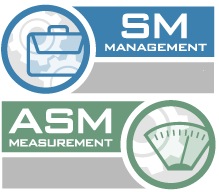SM/ASM 2002 - Software Management & Applications of Software Measurement

PRESENTATIONS
|
Failure is Not an Option: 24 x 7 on the Web
This paper discusses the factors involved in determining the cost of a twenty-four hour by seven days per week (24 X 7) e-Commerce or internal web site going offline for any length of time. After determining these costs, and showing a real-life example calculation, the paper then goes into several ways to minimize this risk via hardware architecture, software architecture, and stress testing. |
|
|
Function Points! It's Our Middle Name
Function points are measures of software size that are critical to any successful measurement program. The International Function Point Users Group (IFPUG) is the non-profit organization responsible for defining the standard, documenting the rules, and promoting function point usage. This session offers an introduction to function points, including their components, usage, and counting process. |
|
|
Get Real! Creating Realistic, Actionable Project Schedules
The preparation of a realistic, practical project schedule is an essential management function for obtaining stakeholder commitment, setting expectations, and communicating within the team and organization what is achievable. Doing this preparation well is another challenge-one that must be conquered. Rex Black helps participants see the bigger project scheduling picture by focusing on issues such as constituent tasks, the underlying dependencies between them, and the risks attached to the completion of those tasks. |

Rex Black, Rex Black Consulting Services, Inc. |
|
High Maturity Benefits and Blarney
With more and more organizations claiming to be Capability Maturity Model (CMM) Level four or five, is high maturity all it's cracked up to be? This talk clarifies what attributes should be present in a true high maturity organization, and presents case studies where organizations benefited substantially from achieving these high maturity capabilities. It also addresses practices that, while they technically quality as high maturity, add absolutely no business value to development and its customers. |

Bill Curtis, TeraQuest |
|
IS and IT Benchmarking: Current Status
Are you having trouble making a business case for benchmarking at your organization? Mark Czarnecki delivers his benchmarking expertise in a presentation designed to help participants impact their corporate culture as well as their benchmarking abilities. He reviews the current status of information systems and technology benchmarking, and he explains current benchmarking theory. The presentation also covers generalized database sources for benchmarking. |
|
|
Iterative Software Development - from Theory to Practice
This paper describes how an iterative software development process has been adopted in RAFAEL, based on the Unified Software Development Process (USDP) introduced by Rational Inc. The paper identifies the core differences between iterative and waterfall software development, addresses the possible difficulties in applying the iterative |
|
|
Managing Iterative Development: Avoiding Common Pitfalls
The Rational Unified Process (RUP) advocates an iterative or spiral approach to the software development lifecycle, as this approach has again and again proven to be superior to the waterfall approach in many respects. But do not believe for one second that the many benefits an iterative lifecycle provides come for free. Iterative development is not a magic wand that when waved solves all possible problems or difficulties in software development. |
|
|
Managing Your Outsourcing Contract Through Metrics
Have project demands led you to consider outsourcing as a possibility? If so, make sure you get the most bang for your company's outsourced buck-and be able to prove it too. Learn about techniques you can use to manage your outsourcing contract based on an appropriate set of service level measures. Koni Thompson also provides specific recommendations for a metrics-centered approach based on the Capability Maturity Model (CMM). |
|
|
Measurement and the CMM: How Measurement Practices Evolve
People who use the Capability Maturity Model (CMM) for software often struggle with the apparent paradigm shift as they move from level to level, particularly when they reach Level four in the CMM one to five level scheme. This presentation illustrates the characteristics of a measurement program at the different CMM maturity levels. It particularly seeks to demystify the Level four concepts of process capability and process performance baselines, and how these concepts are applicable to all CMM levels. |
|
|
Measurement: The CEO Viewpoint
Software managers, process engineers, and measurement specialists often evaluate measurement and metrics based on how they help the software and its customers. Yet it's just as important to think about and quantify how they help the business. In this presentation, Don Winter shares the perspective of measurement from the top-more specifically, which numbers are most critical to the corporate bottom line. |
|


